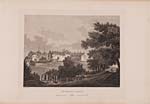(61) Plate XXVIII/a
Download files
Individual page:
Thumbnail gallery: Grid view | List view

Plate XXVIII.
MELROSE ABBEY.
THE old monastery of
Melrose, which was founded about the end of the sixth century, has
long been
destroyed. The magnificent abbey, the ruins of which still remain,
was indebted for its existence to the
piety and munificence of King David in 1136, and was dedicated to
the Virgin Mary. Many of his
successors to the Scottish throne, as well as several rich
noblemen, added considerably to its demesnes and
revenues. William, Alexander II, and Robert Bruce, may be reckoned
among the former. The family
of the Stuarts also added to its wealth, as did the Earl of March,
Lord Yester, the Earl of Douglas, and
several others. Its Abbots were highly esteemed for their piety and
learning, more particularly the son of
King David, its founder, who was its second Abbot. The monks were
Cistertians, and this was the
mother-abbey to all of the same order in Scotland; and on its
dedication the monks were brought from the
abbey of Rievalle in Yorkshire.
The situation of this
monastery, in the county of Roxburgh, made it liable, from its
vicinity to the
English borders, to the frequent hostile attacks of its southern
neighbours. It has consequently suffered
much. Edward II. is said to have burnt it on his return from his
expedition into Scotland in 1322, and it
was frequently injured by the different armies in the reigns of
Richard II, and Henry VIII. Its complete
destruction, however, was deferred to a later period. The situation
of these magnificent ruins, the pride of
Scotland, on the banks of the Tweed, and surrounded with wood, is
truly delightful; and the scenery, in
approaching the little town of Melrose, is very picturesque. The
bridge of Darnick on the left, the
Eildon hills on the right, make a pleasing picture, which the
magnificent remains of the abbey in the centre,
and the winding vale of Tweed, losing itself in distance, complete
the composition. These gothic ruins
are certainly the finest in the kingdom, and, even in their present
state, the sculpture and tracery work,
from the hardness of the stone, preserve the sharpness and
precision almost of modern work. A small
part of it is fitted up, and is still made use of, as a place of
worship. The chancel is the most perfect, and
has still the roof remaining, which is curiously embellished with
Scripture history. The building is in
the shape of a cross, the length 258 feet, the breadth 137, and the
circumference 943. The tracery of
the windows, particularly of the eastern, is rich, yet light and
elegant; and the whole of the interior work
marks it as one of the finest structures of the age.—This inside
view was made in 1799.
Set display mode to:
![]() Universal Viewer |
Universal Viewer | ![]() Mirador |
Large image | Transcription
Mirador |
Large image | Transcription
Images and transcriptions on this page, including medium image downloads, may be used under the Creative Commons Attribution 4.0 International Licence unless otherwise stated. ![]()
| Scotia depicta > (61) Plate XXVIII/a |
|---|

